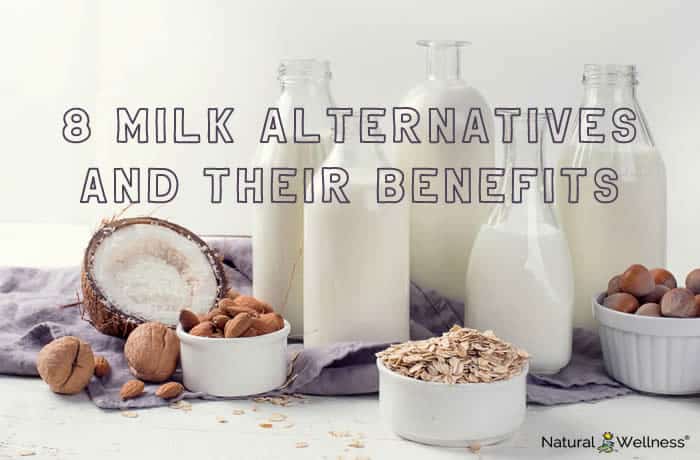

In November 2019, one of America’s largest milk producers filed for bankruptcy protection. This bankruptcy could likely be due to the decline in dairy industry sales last year. According to Dairy Farmers America (1), total milk sales dropped 1.1 billion dollars from 2017 to 2018.
While dairy sales have been declining, oat milk and non-dairy milk blends have seen their highest growth over a 52-week period that ended in June 2018. Dollar sales for oat milk increased by 23%, and other non-dairy milk blends increased by 51%. (2)
Cow’s milk contains essential nutrients, calcium, and protein but is a beverage that not everyone enjoys. Some people can have trouble digesting cow’s milk (lactose intolerance or sensitivity) or follow a vegan diet. For this reason, milk alternatives can be beneficial.
When it comes to choosing a milk alternative, you will want to pay attention to ingredient lists, as many can contain added sweeteners. Avoid options such as vanilla-flavored or chocolate, which commonly contain those added sugars.
Consider the following milk alternatives if you are looking for a replacement for cow’s milk.
Soy Milk
Soy was the “original” milk introduced as a replacement for cow’s milk in the 1950s. It is created by soaking, crushing, cooking, and straining soybeans. Soy milk is the only milk alternative that has a comparable amount of protein as a cup of cow’s milk, along with omega-3 fatty acids and fiber. It is a good source of magnesium and manganese, and manufacturers fortify soy milk with vitamins A, D, B12, and calcium. (3)
Almond Milk
Almond milk has been increasing in popularity, especially among individuals who cannot drink soy milk due to allergies or other health concerns. Its contents consist of ground almonds and water. Due to this high dilution with water, most nutrients found in nuts will be minimal. The lack of nutrients includes low amounts of protein, manganese, magnesium, and copper.
Almond milk does provide high amounts of vitamin E and can be fortified to match the vitamin and mineral content of cow’s milk. (3)
Cashew Milk
Cashew milk is another nut-based alternative that is created by blending water with water-soaked cashews. It typically runs about 60 calories per cup and contains no saturated fat or cholesterol. Cashew milk tends to be creamier than almond, which could pair well with coffee, tea, or even cereal.
After the fortification process, cashew milk can provide close to 50% more calcium than cow’s milk, be an excellent source of vitamin D, and provide 50% of the recommended daily value for vitamin E in one 8 ounce cup. (3)
Pea Milk
One of the newer forms of milk alternative, pea milk is created from yellow field peas. The process starts with milling the peas into flour, separating the protein content from the fiber and starch, and then blending the protein with water and other ingredients. This process allows pea milk to have a naturally high protein content compared to nut-based options, providing at least 7 grams of protein per 8 ounces.
Similar to the other milk alternative options, pea milk goes through a fortification process, and it contains 150% more calcium than cow’s milk. Another benefit is that the taste and consistency of pea milk compares to cow’s milk. (3)
Hemp Milk
Created from the hulled seeds of the industrial hemp plant, which includes Cannabis sativa low in THC (or the psychotropic substance of cannabis), hemp milk is an ideal milk alternative for individuals who cannot consume gluten, nuts, or soy. Since it has an earthier flavor, some consumers may only enjoy sweetened versions of this milk.
Hemp milk provides a three-to-one ratio of omega-6 to omega-3 essential fatty acids, including approximately 1,000 milligrams of alpha-linolenic acid. Compared to other milk-alternatives, hemp contains more protein at 2 to 3 grams per 8 ounces, which is still not a great source. Magnesium, phytosterols, calcium, fiber, iron, and potassium are additional nutrients found in hemp milk. (3)
Rice Milk
The significance of choosing rice milk over other milk alternatives is that it could be the most hypoallergenic option. Rice milk is created by boiling brown rice and brown rice starch, creating a thin consistency with no fiber. The amount of protein is low compared to cow’s milk, at only 1 gram per 8 ounces, and does not contain much natural calcium. (3)
Oat Milk
Oat milk is made from cleaned, toasted, and hulled oats combined with water and possibly other grains and beans. It is low in calories, cholesterol, and saturated fat – and higher in fiber than other milk alternative options. It could contain upwards of 2 grams of fiber per cup depending on if the oat bran is present. Oat milk also provides 4 grams of protein per cup and contains iron, vitamin E, and folic acid.
If you are used to drinking 1% or skim cow’s milk, oat milk may be a good alternative for you as its consistency is similar with a mild flavor and slight sweetness. (3)
Coconut Milk
Coconut milk is often found canned and used for cooking purposes rather than drinking. It is made from grated and squeezed coconut meat, providing higher calories and fat. A “coconut milk beverage” can also be found in dairy aisles, which is a diluted version of the canned content, allowing it to be more drinkable and reducing calorie and fat content.
Whether you use the canned version or diluted, coconut milk will provide medium-chain triglycerides, high amounts of potassium, fiber, and iron. It can also be a good source of vitamin D if fortified. (3)
Are Milk Alternatives Better Than Cow’s Milk?
Dairy foods are good sources of nutrients such as:
- protein
- vitamin D
- calcium
- and phosphorus.
Consumers must be aware of the nutrition content of milk alternatives if they are planning to replace dairy, as milk alternatives are often low in these nutrients. For example, almond milk, which is one of the most popular non-dairy options, contains only 1 gram of protein compared to the 8 grams that come from cow’s milk in an 8 ounce portion. When it comes to nutrients, milk alternatives can be fortified with various nutrients so that they are comparable to cow’s milk.
There are many protein sources available to us, but they are not created equally. The quality of protein is based on biological value, which expresses the effectiveness of said protein in terms of being utilized for growth (4). Protein that comes from animal sources is considered “complete” proteins and contain all the essential amino acids required by humans. Cow’s milk contains whey and casein proteins, which places it at a high biological value due to how well the body can use them. When it comes to plant-based sources, soy milk has recognition for its high biological value (3).
Another factor to consider is the sugar content of milk alternatives. Many sweetened versions can contain upwards of 20 grams of sugar, compared to the 12.5 grams of naturally occurring lactose that is found in 2% cow’s milk (3). It’s essential to choose options that are unsweetened or unflavored to avoid that additional sugar consumption. The downfall of this is it may compromise the taste of the product, as sugar is typically added to make them more palatable.
Best Milk-Alternative for Toddlers
When a child turns 12 months old, the introduction process to fortified cow’s milk can begin. Growing children need vitamins and minerals, such as vitamin D and calcium, to build strong bones. To meet their calcium needs, pediatricians recommend that children drink about 16 to 24 ounces of fortified cow’s milk each day. (5)
Some children are not able to begin drinking cow’s milk, possibly due to a milk allergy, health concerns, or just dislike of the taste. According to the USDA, 1 cup of soy milk or oat milk has the closet nutrient breakdown to 1 cup of whole cow’s milk.
Here is the nutrition breakdown for 1 cup of soy milk (6):
- 105 calories
- 6 grams of protein
- 3.5 grams of total fat
- 300 milligrams of calcium
- 108 international units (IU) of vitamin D
1 cup of oat milk (7):
- 130 calories
- 4 grams of protein
- 2.5 grams of total fat
- 350 milligrams of calcium
- 100 IU of vitamin D
Compared to the nutrition content of 1 cup of whole milk (8):
- 149 calories
- 7.5 grams of protein
- 8 grams of total fat
- 276 milligrams of calcium
- 128 IU of vitamin D
Before deciding which milk alternative to introduce to your child, have a discussion with their pediatrician to ensure they are getting the proper vitamins and minerals.




